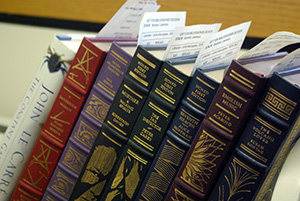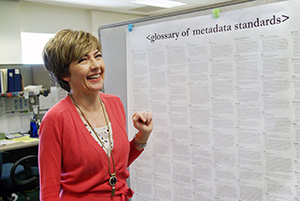eNews Edition: Summer 2013

Come this fall, much of the Library’s interior space will have been transformed to meet the expanding needs of faculty and students. The new Learning Commons will offer a far more open, multifunctional and dynamic space on the first floor; the lobby will boast an expanded and permanent Freudian Sip; and the University’s Learning Resource Center will have a new home in the third floor east wing. The ongoing renovation of the physical space is in large part an inevitable response to the quickly evolving nature of how information is accessed and managed. The ever-expanding availability of electronic resources requires fewer volumes and more voltage. While these changes to the visible structure will be clearly evident, the corresponding and necessary morphing of the Library’s infrastructure might have gone completely unnoticed. Might have, that is, except for the two new names on the organization’s two major departments.
Effective July 1, 2013 - after much deliberation, consultation, and a vote by the Library faculty - the Library’s Technical Services Department, which is traditionally responsible for the life cycle of the library collection (selection, acquisition, cataloging, and physical processing), will be known as Collection Access and Management Services (CAMS). Helen Heinrich, the chair of Collection Access and Management Services, refers to the department as the “backbone” of Library operations. In today’s electronic environment, however, there is much more involved than barcoding, labeling and bindery. Management of access to e-resources; maintenance of ER databases; negotiation of licensing terms; responsibility for digital archives and CSUN’s scholarly repository, ScholarWorks, including the curation of content and creation of metadata for these collections; the responsibility for all of these functions resides with Collection Access and Management Services, according to Heinrich.
 Reference and Instructional Services, the Library’s other major department, also will be rechristened this summer. According to Lynn Lampert, chair of the newly named Research, Instruction, and Outreach Services (RIOS), the department is responsible for assisting students, faculty and community members with their research, as well as helping all patrons utilize the collections held by the Oviatt Library to their maximum potential. The department’s librarians traditionally provide reference services and assist students in selecting, locating and using materials to complete assignments. Now, in today’s modern Library, many of these services are provided electronically via email, text, and a 24/7 Online Virtual Reference Chat Room Service. RIOS also offers instructional services through both face-to-face and online interactions, and partners with faculty and other campus entities to integrate information literacy instruction into University coursework and instructional planning. According to Lampert, it was important the new name include the term outreach. “Our department is also deeply committed to our outreach efforts within and beyond the campus community,” Lampert says. “Through the Reference and Instructional Services Department, the Oviatt Library provides tours and lectures, in addition to resources and services, for many schools within the San Fernando Valley.” Lampert also explained that the adoption of the term research over reference in the new name was a recognition that ‘reference’ is a library science term; while relevant to many, it does not necessarily encompass the full thrust of all that Research, Instruction, and Outreach Services does.
Reference and Instructional Services, the Library’s other major department, also will be rechristened this summer. According to Lynn Lampert, chair of the newly named Research, Instruction, and Outreach Services (RIOS), the department is responsible for assisting students, faculty and community members with their research, as well as helping all patrons utilize the collections held by the Oviatt Library to their maximum potential. The department’s librarians traditionally provide reference services and assist students in selecting, locating and using materials to complete assignments. Now, in today’s modern Library, many of these services are provided electronically via email, text, and a 24/7 Online Virtual Reference Chat Room Service. RIOS also offers instructional services through both face-to-face and online interactions, and partners with faculty and other campus entities to integrate information literacy instruction into University coursework and instructional planning. According to Lampert, it was important the new name include the term outreach. “Our department is also deeply committed to our outreach efforts within and beyond the campus community,” Lampert says. “Through the Reference and Instructional Services Department, the Oviatt Library provides tours and lectures, in addition to resources and services, for many schools within the San Fernando Valley.” Lampert also explained that the adoption of the term research over reference in the new name was a recognition that ‘reference’ is a library science term; while relevant to many, it does not necessarily encompass the full thrust of all that Research, Instruction, and Outreach Services does.
 In both cases these name changes are clearly a reflection of the transformation that CAMS and RIOS have been undergoing for a number of years. Of course, as with any departmental name change within the framework of a larger institution, there will be some logistical ramifications. At CSUN this will include, among other thing: changes to titles and references; SOLAR encoding updates; updated signage; and business card and stationery changes. Far outweighing these few, short-term challenges, however, will be the long-lasting benefits of having two department names that now more accurately communicate their unique responsibilities and more clearly explain the vital role that each of them plays in our University Library’s organization.
In both cases these name changes are clearly a reflection of the transformation that CAMS and RIOS have been undergoing for a number of years. Of course, as with any departmental name change within the framework of a larger institution, there will be some logistical ramifications. At CSUN this will include, among other thing: changes to titles and references; SOLAR encoding updates; updated signage; and business card and stationery changes. Far outweighing these few, short-term challenges, however, will be the long-lasting benefits of having two department names that now more accurately communicate their unique responsibilities and more clearly explain the vital role that each of them plays in our University Library’s organization.


